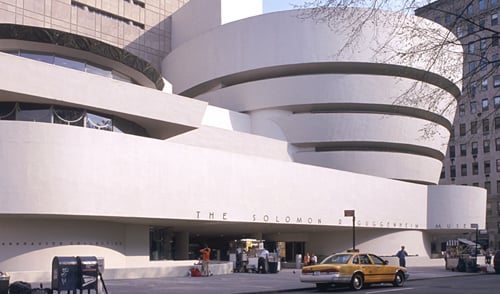One of the great architectural achievements of the
20th century, Frank Lloyd Wright’s 1959 spiral design alone would make
this museum a must. Solomon Guggenheim’s core collection of Abstract art
has been widened by donations of several important collections. The
museum owns a host of work by Brancusi, Calder, Klee, Chagall, Miró,
Leger, Mondrian, Picasso, Oldenberg, and Rauschenberg. Only a small
portion, changed periodically, is displayed, as the main gallery is used
for temporary exhibits. Sections of the Thannhauser collection, which
includes masterpieces by Cézanne, Gauguin, van Gogh, and Picasso, are
always on view. The Guggenheim has the largest collection of Kandinsky’s
works in the U.S. The Kandinsky Gallery contains permanent displays.
1071 5th Ave at 89th St 212 423 3500
www.guggenheim.org
Open 10am–5:45pm Sat–Wed, 10am–7:45pm Fri Adults $18, students and seniors (with valid ID) $15, children under 12 and members free, 5:45–7:45pm Fri donation only.
|
|
Though Wright (1867–
1959) designed many public buildings, he was best known for residential
designs, “organic architecture” that followed the natural contours of
the land, and tradition-breaking open interior spaces that have had
lasting worldwide influence. The Guggenheim, one of his last projects,
was a complete departure. So intent was Wright on his spiral design that
when told some walls were too short for large works, he reportedly
responded, “cut the paintings in half.”
|

Façade of the Guggenheim Museum
|
The café on the main floor is a good spot to rest your feet.
|
|
|
The best way to see the museum is to take the elevator to the skylighted top and wind your way back down.
|
|
|
Free audio tours cover Frank Lloyd Wright architecture and the permanent collection.
|
|
|
There is a regular daily program of interpretive tours. Check the main desk for current schedules.
|
|
Top 10 ExhibitsWoman Ironing Picasso’s
early paintings showed sympathy for the working class. This striking
1904 canvas uses angular contours and a bleak palette of whites and
grays to make the subject a symbol of the misfortunes of the poor. Woman with Yellow Hair In
this memorable portrait from 1931, Picasso portrays the supple body and
golden tresses of his mistress, Marie-Thérèse, one of his favorite
subjects. He employed the continuous arched line from forehead to nose
that he would often repeat in the many paintings of his young muse. Mountains at Saint-Remy Van
Gogh was recovering from an attack of mental distress when he painted
this scene in July 1889, one year before his suicide. The subject was
the low range of the Alpilles mountains in southern France, visible from
his hospital grounds. The bold brush strokes are characteristic of van
Gogh’s later work. Before the Mirror Edouard
Manet scandalized Paris with his paintings of prostitutes and
courtesans. This private scene is of a partially undressed woman, an
actress perhaps, contemplating her image. Haere Mai Gauguin
made his first trip to Tahiti in 1891 in search of a paradise untainted
by Western culture. This idyllic village landscape was painted during
that trip; the rich hues and flattened forms show the simplicity he
sought. The phrase “Haere Mai,” (“Come Here”) is painted into the left
corner. Still Life: Flask, Glass, and Jug Paul
Cézanne’s later style, based on the interplay of surface and depth, is
shown in this 1877 painting. His mastery of space and depth, as seen in
the mottled apples in the foreground, make him the foremost precursor of
Cubism. Bibémus In
Bibémus, the abandoned quarries outside Aix-en-Province, France,
Cézanne found a manmade landscape that suited his increasingly geometric
style. He painted many variations of this scene from 1895–9. The Hermitage at Pontoise This
unsentimental rendering of the village where Pisarro lived on and off
from 1866–83 emphasizes the use of light and shade. The depiction of
villagers was thought vulgar by some painters of the day. Black Lines Kandinsky
wanted the undulating, richly-colored ovals and animated black
brushstrokes to elicit specific reactions from viewers. Black Lines (1913) is one of his best-known non-objective works. Paris Through the Window Painted
after Chagall moved to Paris from Russia in 1910, the scene reflects
the latest avant garde styles. The Eiffel Tower seen in the distance is a
metaphor for Paris and for modernity.
|